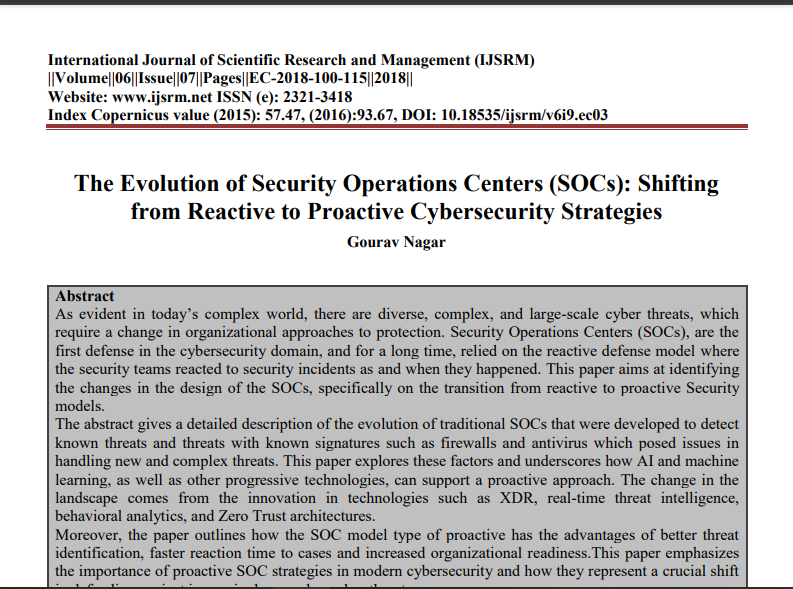The Evolution of Security Operations Centers (SOCs): Shifting from Reactive to Proactive Cybersecurity Strategies

Submission to VIJ 2018-09-29
Copyright (c) 2018 Gourav Nagar

This work is licensed under a Creative Commons Attribution 4.0 International License.
Abstract
As evident in today’s complex world, there are diverse, complex, and large-scale cyber threats, which require a change in organizational approaches to protection. Security Operations Centers (SOCs), are the first defense in the cybersecurity domain, and for a long time, relied on the reactive defense model where the security teams reacted to security incidents as and when they happened. This paper aims at identifying the changes in the design of the SOCs, specifically on the transition from reactive to proactive Security models.
The abstract gives a detailed description of the evolution of traditional SOCs that were developed to detect known threats and threats with known signatures such as firewalls and antivirus which posed issues in handling new and complex threats. This paper explores these factors and underscores how AI and machine learning, as well as other progressive technologies, can support a proactive approach. The change in the landscape comes from the innovation in technologies such as XDR, real-time threat intelligence, behavioral analytics, and Zero Trust architectures.
Moreover, the paper outlines how the SOC model type of proactive has the advantages of better threat identification, faster reaction time to cases and increased organizational readiness.This paper emphasizes the importance of proactive SOC strategies in modern cybersecurity and how they represent a crucial shift in defending against increasingly complex cyber threats.
References
- Zimmerman, C. (2014). Cybersecurity operations center. The MITRE Corporation.
- Onwubiko, C. (2015, June). Cyber security operations centre: Security monitoring for protecting business and supporting cyber defense strategy. In 2015 international conference on cyber situational awareness, data analytics and assessment (cybersa) (pp. 1-10). IEEE.
- Muniz, J., McIntyre, G., & AlFardan, N. (2015). Security operations center: Building, operating, and maintaining your SOC. Cisco Press.
- Wang, J. (2010). Anatomy of a security operations center (No. ARC-E-DAA-TN2004).
- Miloslavskaya, N. (2016, August). Security operations centers for information security incident management. In 2016 IEEE 4th International Conference on Future Internet of Things and Cloud (FiCloud) (pp. 131-136). IEEE.
- Michail, A. (2015). Security operations centers: A business perspective (Master's thesis).
- Aijaz, L., Aslam, B., & Khalid, U. (2015, September). Security operations center—A need for an academic environment. In 2015 World Symposium on Computer Networks and Information Security (WSCNIS) (pp. 1-7). IEEE.
- Hull, J. L. (2017). Analyst burnout in the cyber security operation center-CSOC: A phenomenological study (Doctoral dissertation, Colorado Technical University).
- Radu, S. G. (2016). Comparative analysis of security operations centre architectures; proposals and architectural considerations for frameworks and operating models. In Innovative Security Solutions for Information Technology and Communications: 9th International Conference, SECITC 2016, Bucharest, Romania, June 9-10, 2016, Revised Selected Papers 9 (pp. 248-260). Springer International Publishing.
- Nathans, D. (2014). Designing and building security operations center. Syngress.
- Gourav N. (2018) Leveraging Artificial Intelligence to Automate and Enhance Security Operations: Balancing Efficiency and Human Oversight. (2018). International Journal of Scientific Research and Management (IJSRM), 6(07), 78-94. https://doi.org/10.18535/ijsrm/v6i7.ec05